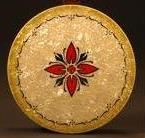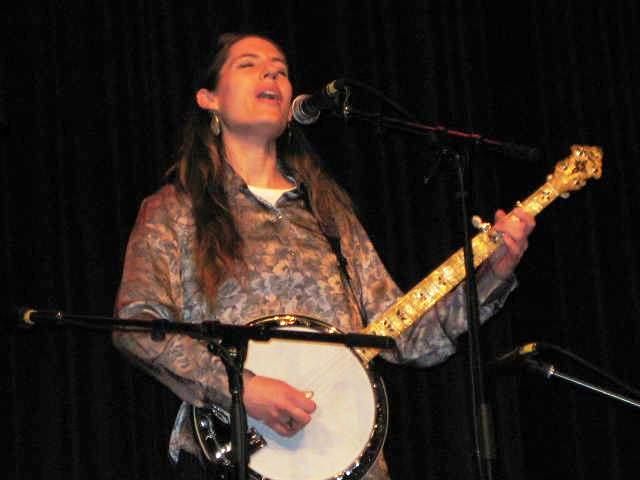
Casey Henry
Banjo Player
Banjo Newsletter
Banjo Camp North
August 2008
It never ceases to amaze me that at banjo camps people from so many different walks of life can get together and commune in perfect harmony. No matter what their culture, politics, or religion, their love for the instrument crosses all such barriers. The particular event I have in mind is Banjo Camp North, a three-day gathering in Groton, Mass., in May, organized by Mike Holmes. I taught there this year for the first time and had a wonderful experience, met some fabulous new friends, and acquired yet another banjo (more on that later).
I have Tom Mirisola to thank for getting me hired at BCN. He owns the American Made Banjo Company, which makes my signature model banjo. I had never met him in person and when I flew in for the camp he sent a limo to pick me up from the airport—a limo! He treated me like royalty all weekend, bringing me a latte and donuts every morning, arranging my ride back to the airport, and supplying me with all the strings I could ever need.

Banjo Camp North kicks off with a Banjo Extravaganza Concert on Thursday night. Most of the instructors play and it gives the new people (i.e. me) a chance to meet everyone. The most surprising person I met was Eric Weissberg. I was previously familiar with Eric by name only, as the person who recorded the famous version of “Dueling Banjos,” used in the soundtrack of “Deliverance.” It had never even occurred to me to wonder what he looked like. It was determined that among all the instructors, he had been playing banjo the longest, beating even Bill Keith by a couple of years.
I was tickled to meet old-time banjo player Mac Benford. He got on my good side right away by complimenting me on my articles in this magazine, so I was pre-disposed to like him. My regard was cemented, though, after I heard him play. He shared the stage with three of the other faculty. They all played fancy pieces with a lot of notes. When it was Mac’s turn he played Walkin’ In The Parlor—simple, elegant, musical—and I knew that he was my kind of people.

The classes and students at BCN were all top-notch. The camp is structured similarly to the Maryland Banjo Academy, with teachers giving workshops on topics of their choice and the students going to whichever they choose—a marked difference from places like the Augusta Heritage Workshops or Kaufman Kamp where students are in the same class all week, either with one teacher, or rotating between teachers.
It’s especially fun for us as teachers to get to teach with other people. And it is sometimes challenging to do a class with people you have never met or worked with before. Everyone has their own teaching style, and some are more compatible than others. My very first class was on improvising, with Bruce Stockwell, Eric Weissberg, and Glenn Nelson, all of whom I had known for less than twenty-four hours. Despite our nascent acquaintance we managed to say some interesting and useful things about how to approach improvising (I think…maybe I should ask the students that!).
On the other hand, I also got to teach some classes with old friends. Bill Evans and I did a workshop on what to do in your first jam session, in which we tried to demonstrate what happens when the person taking the lead break gets out of sync with the rest of the jam. In such a case, almost always, the rest of the jam has to give in to the lead player in order to keep a train wreck from happening. Bill did an admirable job of playing a song wrong (quite hard to do on purpose!) and staying out of sync with me until I gave in, restoring the equilibrium.
Several different vendors came to set up their wares at BCN. Among these was a banjo builder from Marlboro, Vermont, named Will Fielding. He makes open-backs, so I didn’t pay too much attention for most of the weekend, until the last day when I thought, what the heck, I’ll go over and play them, even though I don’t know much that is suitable to play on an open-back. He had some truly gorgeous banjos with beautifully carved heels and engraved inlays. I played several, and even (bravely) tried the fretless one that he had there. I had to quickly dash off and teach a class so I was a little surprised when I couldn’t get that fretless banjo out of my head. I could remember just how it felt in my hands and how I liked that warm, plunky sound.
I couldn’t have played it for more than two minutes, so it was basically love at first sight (first touch? first sound?). I went home and thought about it for a while, so I wouldn’t be seen as acting rashly, and then sent him a check about a week later. When the UPS driver brought it to my door, I was in the middle of teaching a lesson. I had to bring it in and then try not to bust for the next hour until I could unpack it. And when I did—whoo hoo what a rush! I’ve had it for six days now and have probably played everything clawhammer I know on it about twenty times, plus have written a little tune. It has inspired me to learn more old-time-style music and I’m so happy just to have it in my hands.
Leaving from camps is always a little sad—to go back to your regular life where not everyone plays and breathes banjos all day. Everyone has flights to catch and you never get to say goodbye to all the people you want to. But it must be done and I caught the shuttle back to the airport. I decided to check my banjo since I had to change planes and I detest carrying it on long walks through airports. I watched as the baggage crew inspected it and then got them to lock the latches so it wouldn’t get knocked open on the way. When I reclaimed my banjo from the baggage carousel in Nashville I immediately opened the case, as I always do, to make sure everything was in good order. As I picked up the instrument I heard something rattling around in the resonator. I thought perhaps that the nut holding on the tailpiece had shaken loose but, when I took off the back, I found a quarter. After one extremely disorienting moment I remembered that it was the coin I had received as a tip while playing for the Super Bowl stage crew volunteers. It had been in the gear pocket of my case. It boggled my mind to think about the amount of shaking around it must have taken for the quarter to work its way out of the pocket and land in the resonator. Thank goodness for Calton cases.
I stepped out of the airport into the night air, humid and heavy with the scent of honeysuckle. It had still been spring in Massachusetts, but I was glad to be back in the summery South. Communing with the Yankees is all well and good, but there’s no place like home.